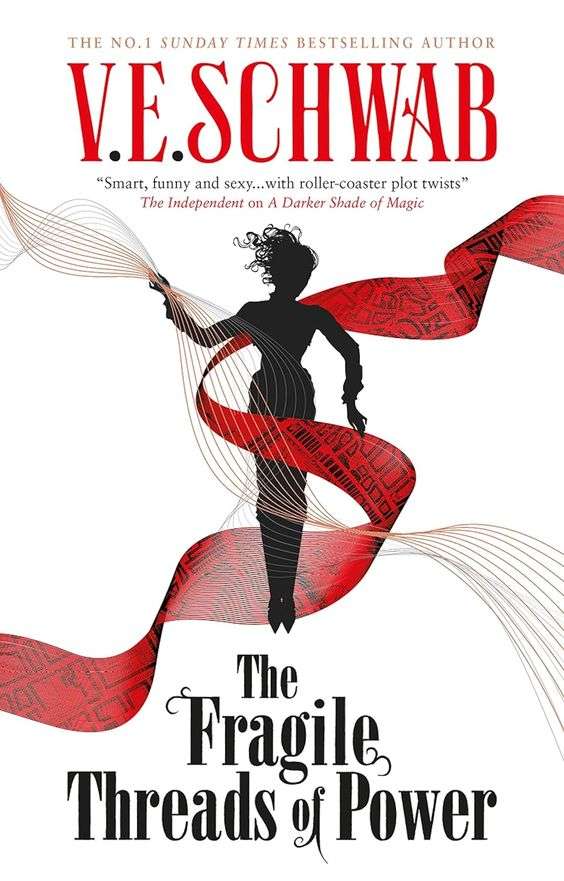We’ve implemented some new protocols around sending us messages via this website. Please email website “at” britishfantasysociety “dot” org for any issues.

For all things fantasy, horror, and speculative fiction
-
Announcement:

The Fragile Threads of Power
The Fragile Threads of Power by V.E. Schwab
Titan Books, h/b £18.99, Ebook £9.99
Review by Tori Borne

In 2015, fantasy lovers were graced by American author V.E. Schwab with the first of the Shades of Magic series, A Darker Shade of Magic, introducing to us not just one world – but four.
Once interlinked and open to those who could command magic, four versions of London – Black, White, Red, and Grey – have been sealed off following the cataclysmic fall of Black London, in which its world was burned up and destroyed by magic.
Now, only the Antari, chosen magicians who can manipulate all elements and utilise their own blood in tandem with Antari words to travel within – and between – worlds can cross the threshold from one London into another.
Schwab’s latest addition to the Shades of Magic collection follows on from 2017’s A Conjuring of Light, which saw Kell, Lila Bard and Holland Vosijk teaming up to battle Osaron, a being of pure magic who wants to colonise Red London, building an empire of magic in which they can rule.
Set seven years after the aforementioned events, the Threads plot involves a conspiracy against the Arnesian Crown and growing rebellion against King Rhy Maresh, a new Antari Queen on the throne of a rising White London, and a young girl who has a particularly rare penchant for magic and tinkering with spelled objects.
Fans of Schwab’s celebrated series will have a lot to love about The Fragile Threads of Power. The world – or worlds, even – that Schwab has so meticulously built is expanded upon as we’re introduced to new locations and variations of magic. And it’s done whilst successfully evoking a sense of familiarity, as Schwab has said herself, of ‘coming home’.
I was pleased to see our original heroes from the previous trilogy back, and not just as cameos, but as main characters and players in the story – it just wouldn’t be a Shades of Magic book without everyone’s favourite red-headed Antari, Kell Maresh. Schwab also introduces new characters, such as the young Antari Queen of White London, Kosika, and my personal favourite, the endearing Tesali, a young girl who can not only see the threads of magic but can touch and twine them. The introduction of Tesali and her rare ability was perhaps my favourite part of the novel as it added another layer to an already intriguing magic system.
However, despite all of the successes of the book – and generally speaking, I thoroughly enjoyed it as a whole – I did find that the constant flashbacks made aspects of the narrative feel a little disjointed. As the main plot takes place seven years following the final book of the original trilogy, Schwab introduces quite a substantial number of flashbacks to fill the gaps – either story-wise or for the purpose of character development (or, in the case of new characters, introduction). I’m conflicted about how I feel about this. Sometimes, it was masterfully done, adding to the suspense of the plot and strengthening the storyline. Other times, it seemed to solely serve the purpose of character development, which is not a negative thing by any means, but it did slow the plot and made parts of the novel feel a little off pacing-wise. For those invested in the characters, they will enjoy these insights into their life during the period between books, but for those looking for a driving plot, this may be a sore point.
My hope for the follow-up novel is that these flashbacks won’t be necessary to bridge gaps, or if necessary, done sparingly. The novel has a genuinely captivating storyline, characters you will love and characters you will loathe, and an absolutely incredible setting. It is a magical novel and, overall, a triumphant return to Red London and the Shades of Magic world.
If you haven’t yet read V.E. Schwab’s Shades of Magic trilogy, I would urge you to do so. The original trilogy is highly acclaimed and more than deserving of its praise. I look forward to seeing where Schwab takes this story next and await with bated breath for the already much-anticipated follow-up to The Fragile Threads of Power.
Explore the blog:
Blog categories:
Latest Posts:
Tags:
#featured (56) #science fiction (25) Book Review (264) events (44) Fantasy (231) Graphic Novel (13) horror (136) Members (62) Orbit Books (48) profile (43) Romance (17) Science Fiction (50) short stories (28) Titan Books (52) TV Review (15)
All reviews
Latest Reviews:
- THE HOUSE ON THE BORDERLAND by William Hope Hodgson
- Monstrum by Lottie Mills
- Mood Swings by Dave Jeffery
- Yoke of Stars by R.B. Lemberg
- Hera by Jennifer Saint
- The Black Bird Oracle by Deborah Harkness
- RETURN OF THE DWARVES By Markus Heitz
- Delicious in Dungeon
- Toxxic by Jane Hennigan
- THIS ISLAND EARTH: 8 FEATURES FROM THE DRIVE-IN By Dale Bailey
Review tags:
#featured (2) Action (4) Adventure (4) Book Review (28) Fantasy (18) Featured (2) Feminist (2) Gothic Horror (3) Horror (14) Magic (3) Orbit Books (3) Romance (6) Science Fiction (5) Swords and Sorcery (2) Titan Books (7)